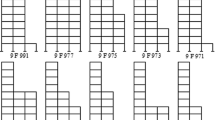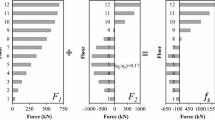Abstract
The recently developed pushover analysis procedure has led a new dimension to performance-based design in structural engineering practices. With the increase in the magnitude of monotonic loading, weak links and failure modes in the multi-storey RC frames are usually formed. The force distribution and storey displacements are evaluated using static pushover analysis based on the assumption that the response is controlled by fundamental mode and no mode shift takes place. Himalayan-Nagalushai region, Indo-Gangetic plain, Western India, Kutch and Kathiawar regions are geologically unstable parts of India and some devastating earthquakes of remarkable intensity have occurred here. In view of the intensive construction activity in India, where even a medium intensity tremor can cause a calamity, the authors feel that a completely up-to-date, versatile method of aseismic analysis and design of structures are essential. A detailed dynamic analysis of a 10-storey RC frame building is therefore performed using response spectrum method based on Indian Standard Codal Provisions and base shear, storey shear and storey drifts are computed. A modal pushover analysis (MPA) is also carried out to determine the structural response of the same model for the same acceleration spectra used in the earlier case. The major focus of study is to bring out the superiority of pushover analysis method over the conventional dynamic analysis method recommended by the code. The results obtained from the numerical studies show that the response spectrum method underestimates the response of the model in comparison with modal pushover analysis. It is also seen that modal participation of higher modes contributes to better results of the response distribution along the height of the building. Also pushover curves are plotted to illustrate the displacement as a function of base shear.
Similar content being viewed by others
References
Vamvatsikos, D. and Cornell, C. A., ‘Incremental dynamic analysis’, Earthquake Engineering and Structural Dynamics 31(3), 2002, 491–514.
Wilson, E. L. and Habibullah, A., ‘Static and dynamic analysis of multistorey buildings including p-delta effects’, Earthquake Spectra, Earthquake Engineering Research Institute 3(3), 1987, 289–298.
Chopra, A. K., Dynamics of Structures – Theory and Applications to Earthquake Engineering 2nd edn., Pearson Education, Singapore, 2003.
Luco, N., Mori, Y., Funahashi, Y., Cornell, C. A., and Nakashima, M., ‘Evaluation of predictors of nonlinear seismic demands using “Fishbone”, models of SMRF buildings’, Earthquake Engineering and Structural Dynamics 32(14), 2003, 2267–2288.
Chandrasekaran, S., Tripathi, U. K., and Srivastava, M., ‘Study of plan irregularity effects on seismic vulnerability of MRFS’, in Proceedings of the Fifth Asia-Pacific Conference on Shock & Impact Loads on Structures, 2003, pp. 125–136.
IS 1893 (part 1), Criteria for Earthquake Resistant Design of Structures. Part 1. General Provisions and Buildings, fifth revision, 2002, Bureau of Indian Standards, New Delhi, India.
Stratta, J. L., Manual of Seismic Design, 1st edn., Pearson Education, Singapore, 2003.
Shome, N. and Cornell, C. A., ‘Structural seismic demand analysis: Consideration of “collapse”, ’, in Proceedings of the Eighth American Society of Civil Engineers Specialty Conference on Probabilistic Mechanics and Structural Reliability, 2000, Norte Dame, July 24–26.
Ghosh, S. K., ‘Seismic design using structural dynamics’, International Code Council, July 2001.
Habibullah, A. and Pyle, S., ‘Practical three dimensional nonlinear static pushover analysis’, Structure Magazine, Winter 1998, Berkeley, CA, USA.
Qian, J. and Zhou, J., Full-Range Pushover Analysis of RC Frame, Project Report of National Natural Science Foundation, PRC, 2003.
Ballard, T. A., Krimotat, A., and Mutobe, R., Utilizing Pushover Analysis for Seismic Performance of Steel Bridge structures, Lecture Notes Extract, 2003.
Jain, S. K., et al., ‘Bhuj, India earthquake of January 26, 2001 reconnaissance report’, Earthquake Spectra, Earthquake Engineering Research Institute, Supplement A to Vol. 18, 2002, 160–185.
Chopra, A. K. and Goel, R. K., ‘A modal pushover analysis procedure to estimate seismic demands for buildings: Summary and evaluation’, in Proceedings of the Fifth National Conference on Earthquake Engineering, Istanbul, Turkey.
FEMA 273. Seismic Rehabilitation Guidelines, Federal Emergency Management Agency, Washington, DC, 1997.
Author information
Authors and Affiliations
Corresponding author
Rights and permissions
About this article
Cite this article
Chandrasekaran, S., Roy, A. Seismic Evaluation of Multi-Storey RC Frame Using Modal Pushover Analysis. Nonlinear Dyn 43, 329–342 (2006). https://doi.org/10.1007/s11071-006-8327-6
Received:
Accepted:
Issue Date:
DOI: https://doi.org/10.1007/s11071-006-8327-6




